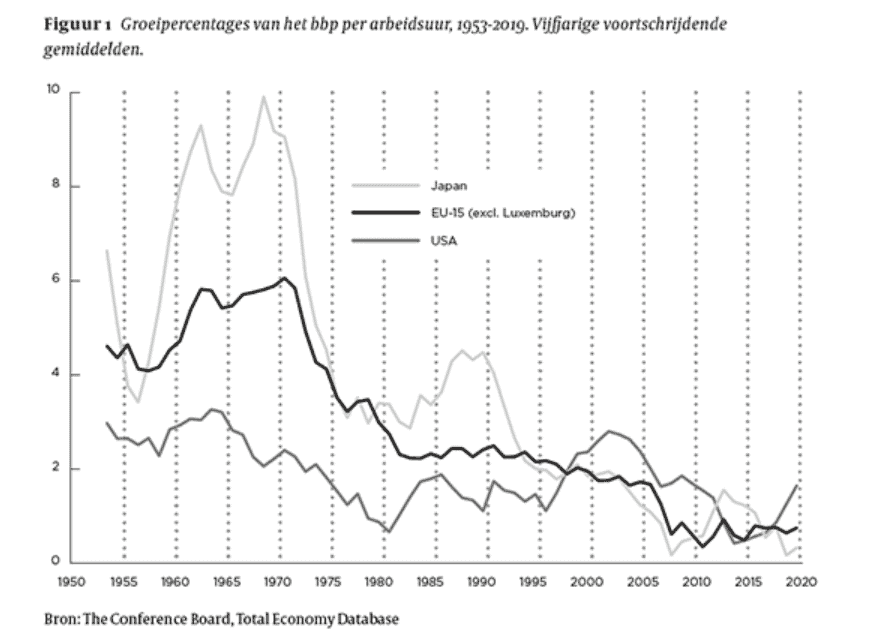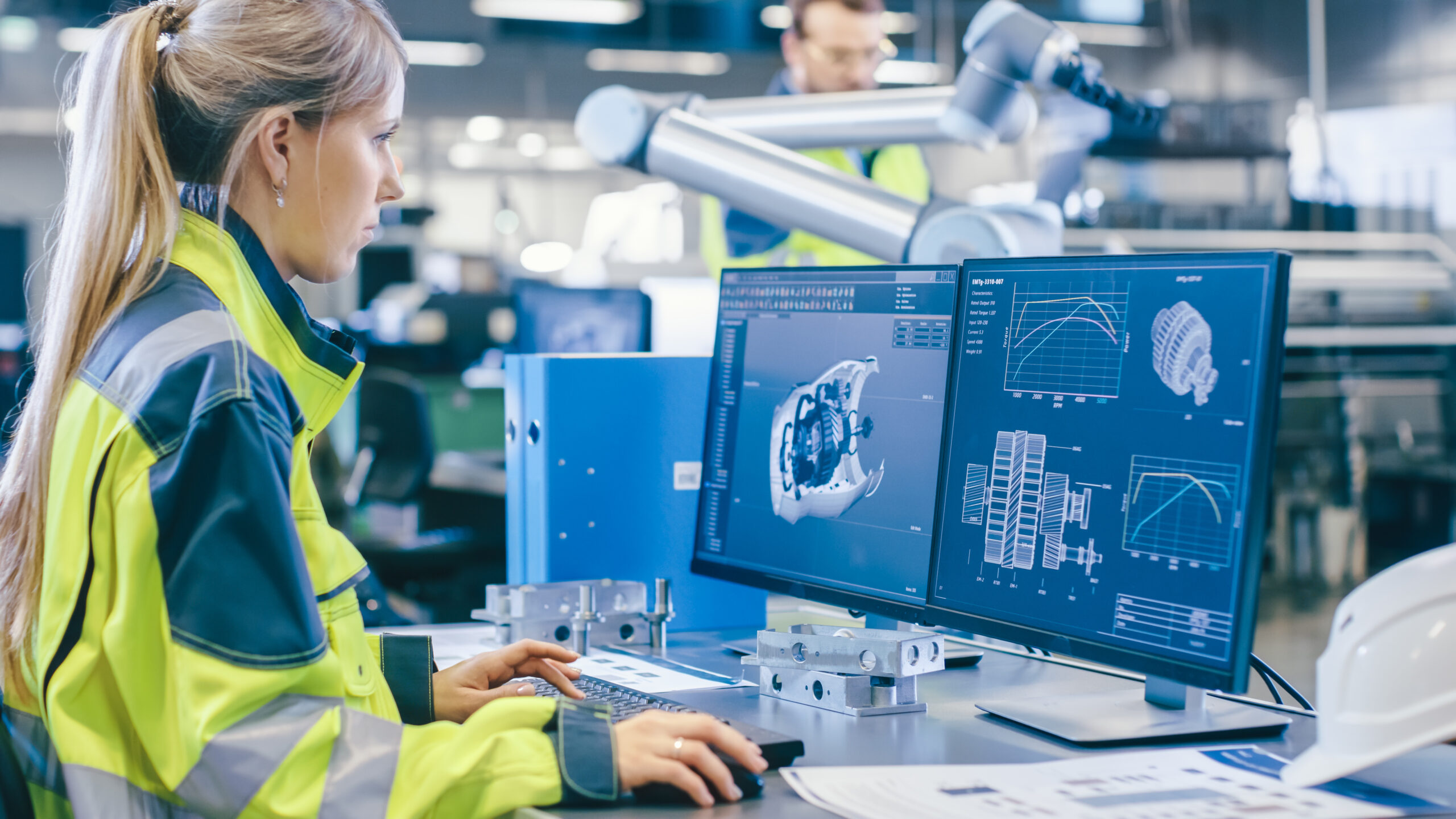
In the Netherlands, that stagnation already began in 2015. “We still have the same added value per worked hour as seven years ago. If you look at the rest of Europe, only Italy is doing worse. There, productivity per hour has not increased since the turn of the century,” says Alfred Kleinknecht, emeritus professor of economics at VU Amsterdam and TU Delft.
Productivity paradox
Anno 2023, we find ourselves in a paradox. New technologies such as robotics, AI and big data are becoming more and more sophisticated, but if you look at the rates of productivity, you get the impression that they are failing to have a real impact.
Things were different between 1950 and 1975, also called the ‘Golden Quarter’, when internet and nuclear energy were discovered, says Henk Volberda. He is a professor Strategy and Innovation at the University of Amsterdam Business School and director of the Amsterdam Centre for Business Innovation. “Back then, productivity went up by four to five percent a year in advanced countries. After 1975 that rate declined; now we are already happy with an increase of half a percent.”
Many technologies are now nearing the end of their cycle. “It is often assumed that technology evolves in a linear fashion; this isn’t always the case. The IT industry is also seeing declining capital gains.”



Cost disease
Kleinknecht: “In the auto industry more and more robots can be found on the work floor. But there are also a lot of industries where modern technology is deployed minimally. Think of the performing arts. The only thing that has been modernized at the Concertgebouw is ticket sales. As far as Beethoven’s Fifth is concerned, no innovation has taken place in the last two hundred years. In economics, we call that ‘cost disease’: where there are hardly any cuts in costs, so the product or service becomes relatively more and more expensive.”
‘Cafetaria economy’
“Then there are other sectors that do lean that way, such as healthcare, hospitality and retail. In Italy, they call it the “cafeteria economy”. Sure, the new espresso machine is more modern than the previous one, and innovations in healthcare services make the work of healthcare workers easier, but they nevertheless continue to be labor-intensive sectors.
The problem is that these sectors are growing at a rapid pace. With an aging population, more and more healthcare staff are needed. That trend will continue is set to continue for at least another 30 years. “To be able to afford everything, you have to get the most out of technology in sectors where you are actually able to modernize, so that fewer jobs will be needed there.”
Robots at the work floor
Consider the adaptation of robots in the workplace. According to figures from the International Federation of Robots, in South Korea and Japan , 6 robots drive around for every 1,000 workers. In Europe, that number was between 1 and 1.5 two decades ago, and grew to 2.5 by 2022. Once again, there is substantial differences even within Europe: for example, in the United Kingdom and the Netherlands, the adaptation of robots is progressing very slowly, while Germany and France are faring much better. So why is that? – Exactly, because these are countries with huge automotive or food industries.
Although that is not just an excuse. Volberda: “In America bricklaying robots are already widely used. In the Netherlands you now see that happening very slowly. So in that we are lagging behind, while we are facing a very big task in construction.”

Hype cycle
Volberda additionally cites the hype cycle as one of the explanations for stagnant productivity rates. “In the beginning, we often have very high expectations about something. Take blockchain technology. The promise was that transactions could take place without an intermediary and the entire banking system would become redundant. Now we see that it can be hacked and disappointment follows; many companies pull out. But, companies that make long-term investments of fifteen to twenty years eventually grab the profit. I think we do have technological breakthroughs, but it just takes time before we see that reflected in the numbers.”
‘Death stare at technology’
Companies can implement new technologies, but technology only determines 25 percent of innovation success, according to Volberda. The other 75 percent is determined by social innovations. So: leadership, the organizational form, new ways of working and co-creation with partners.
At companies experimenting with robots, productivity is likely to decline rather than increase at first. Those robots bring uncertainty and resistance – in economics called the ‘J-curve’. “But, if they keep investing long-term, those robots will really pay off. It is important for companies not to stare dead on technology. If you want to digitize and automate, you have to map processes well. Management innovation is at least as important as technological innovation. Research shows that countries that are good at management innovations, think lean, agile and scrum, also have higher productivity rates.”
Wage moderation stymies modernization
Another reason for stagnant work productivity is that capital investment is slowing down in the Netherlands, according to Kleinknecht. “Wage moderation has been prevalent in the Netherlands since the 1980s. Due to the low pressure on labor costs, the proliferation of modern process technologies and the modernization of manufacturing equipment is advancing very slowly.”
This is how it works. Take the capital stock of a company. You can assume that the oldest equipment is the least productive and the newest the most productive. If wages do not rise (fast enough), a company can keep older machinery running longer. After all, wages are not too costly, which means that older machinery and technology can last longer. As soon as wages rise, older equipment is replaced more quickly; it becomes unprofitable much sooner.
“If I have a bus load of cheap workers coming in from abroad who work very hard, that’s usually more cost-effective than spending capital on costly expenditure. Therefore, as long as wages remain low, robots and other expensive technologies have a hard time competing with a labor force,” Kleinknecht explains.

Flexible work
The increasingly flexible labor market in Europe is also causing technology to proliferate relatively slowly. People can be fired more easily and are changing jobs more often. While companies, especially tech companies, benefit enormously from people staying on longer. After all, that’s where the knowledge is.
Kleinknecht: “Take Tesla. People are constantly coming and going there. A lot of processes don’t work then; people have to be continually trained up. The manufacturing standard of a Tesla is around the level of European cars from the 1980s. That is typical of a highly flexible labor market and one of the reasons why the auto industry in the United States is unable to compete with Europe or Asia.”
“The manufacturing standard of a Tesla is around the level of European cars from the 1980s.”
Alfred Kleinknecht
A new Golden Quarter
First there was the steam engine, then electricity and industrialization, then ICT and the computer, now we have AI, robotization and VR. It just might be that we are on the eve of the fourth industrial revolution Volberda suggests. A McKinsey study, for example, shows that the productivity gains that came with the advent of electricity are disproportionate to the productivity gains AI will bring us.
“Many new, breakthrough technologies are still in development. Take Chat GPT, which offers enormous potential. Accountants, for example, can automate many processes and increase their productivity tremendously. I think we still have to be patient for a while, it could just be that between 2025 and 2050 we arrive in a new Golden Quarter. And then, we do see the effects of all the new technologies reflected in productivity.”

